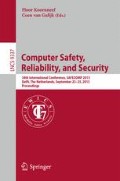Abstract
Safety requirement specifications usually have heterogeneous structures, most likely based on the experience of the engineers involved in the specification process. Consequently, it gets difficult to ensure that recommendations given in standards are considered, e.g., evidence that the requirements are complete and consistent with other development artifacts. To address this challenge, we present in this paper the Safety Requirements Decomposition Pattern, which aims at supporting the decomposition of safety requirements that are traceable to architecture and failure propagation models. The effectiveness of the approach has been observed in its application in different domains, such as automotive, avionics, and medical devices. In this paper, we present its usage in the context of an industrial Automated External Defibrillator system.
Access this chapter
Tax calculation will be finalised at checkout
Purchases are for personal use only
Notes
References
Hatcliff, J., Wassyng, A., Kelly, T., Comar, C., Jones, P.: Certifiably safe software-dependent systems: challenges and directions. In: FOSE 2014, Hyderabad, India (2014)
International Organization for Standardization: ISO/DIS 26262 - Road Vehicles – Functional Safety. Technical Committee 22 (ISO/TC 22), Geneva, Switzerland (2011)
Adler, R.: Introducing quality attributes for a safety concept. SAE Technical Paper 2013-01-0194, Detroit, Michigan, USA (2013)
Maeder, P., Jones, P.L., Zhang, Y., Cleland-Huang, J.: Strategic traceability for safety-critical projects. IEEE Softw. 30(3), 58–68 (2013)
DO-178C/ED-12C: Software Considerations in Airborne Systems and Equipment (2011)
ANSI/AAMI/IEC 62304:2006: Medical Device Software—Software Life Cycle (2006)
International Organization for Standardization: ISO/IEC/IEEE 29148:2011 Systems and software engineering - Life cycle processes - Requirements engineering. IEEE (2011)
Kaiser, B.: Approaches Towards reusable safety concepts. Presentation at the VDA Automotive SYS Conference, Berlin, Germany (2012)
Antonino, P.O., Trapp, M.: Improving consistency checks between safety concepts and view based. Architecture design. In: PSAM12, Honolulu, Hawaii, USA (2014)
Cleland-Huang, J., Goetel, O., Hayes, J.H., Maeder, P., Zisman, A.: Software traceability: trends and future directions. In: FOSE 2014, Hyderabad, India (2014)
Kruchten, P.: The 4+1 view model of architecture. IEEE Softw. 12, 42–50 (1995)
Clements, P., Garlan, D., Bass, L., Stafford, J., Nord, R., Ivers, J., Little, R.: Documenting Software Architectures: Views and Beyond. Pearson Education, Upper Saddle River (2002)
Hofmeister, C., Nord, R., Soni, D.: Applied Software Architecture, 1st edn. Addison-Wesley Professional, Boston (2009)
Pohl, K., Hoenninger, H., Achatz, R., Broy, M.: Model-Based Engineering of Embedded Systems - The SPES 2020 Methodology. Springer, Heidelberg (2012)
Avizienis, A., Laprie, J.C., Randell, B., Landwehr, C.: Basic concepts and taxonomy of dependable and secure computing. IEEE Trans. Dependable Secure Comput. 1(1), 11–33 (2004)
Douglass, B.P.: Real-Time Design Patterns: Robust Scalable Architecture for Real-Time Systems. Addison-Wesley Longman Publishing, Boston (2005)
Fenelon, P., McDermid, J.A., Nicolson, M., Pumfrey, D.J.: Towards integrated safety analysis and design. ACM SIGAPP Appl. Comput. Rev. - Special Issue on Safety-Critical Software 2, 21–32 (1994)
Wu, W., Kelly, T.: Deriving safety requirements as part of system architecture definition. In: 24th International System Safety Conference, Albuquerque, USA (2006)
International Organization for Standardization: IEC 61508 - Functional safety of electrical/electronic/programmable electronic safety-related systems, Geneva, Switzerland (1998)
American Heart Association, ECC Guidelines. http://circ.ahajournals.org/content/102/suppl_1/I-60.full. Accessed March 2015
Habli, I., Ibarra, I., Rivett, R., Kelly, T.: Model-based assurance for justifying automotive functional safety. SAE Technical Paper 10AE-0181, Detroit, USA (2010)
Katta, V., Stålhane, T.: A conceptual model of traceability for safety systems. In: 2nd Complex Systems Design & Management Conference (CSD&M 2011), Paris, France (2011)
Birch, J., Rivett, R., Habli, I., Bradshaw, B., Higham, D., Jesty, P., Monkhouse, H., Palin, R.: Safety cases and their role in ISO 26262 functional safety assessment. In: Bitsch, F., Guiochet, J., Kaâniche, M. (eds.) SAFECOMP 2013. LNCS, vol. 8153, pp. 154–165. Springer, Heidelberg (2013)
Beckers, K., Côté, I., Frese, T., Hatebur, D., Heisel, M.: Systematic derivation of functional safety requirements for automotive systems. In: Bondavalli, A., Di Giandomenico, F. (eds.) SAFECOMP 2014. LNCS, vol. 8666, pp. 65–80. Springer, Heidelberg (2014)
Antonino, P.O., Trapp, M., Venugopal, A.: Automatic detection of incomplete and inconsistent safety requirements. SAE Technical Paper 2015-01-0268, Detroit, USA (2015)
Acknowledgements
This work is supported by the Fraunhofer Innovation Cluster Digitale Nutzfahrzeugtechnologie. We would also like to thank Sonnhild Namingha for proofreading, and to the head of NUTES Prof. Dr. Misael Morais.
Author information
Authors and Affiliations
Corresponding author
Editor information
Editors and Affiliations
Rights and permissions
Copyright information
© 2015 Springer International Publishing Switzerland
About this paper
Cite this paper
Antonino, P.O., Trapp, M., Barbosa, P., Gurjão, E.C., Rosário, J. (2015). The Safety Requirements Decomposition Pattern. In: Koornneef, F., van Gulijk, C. (eds) Computer Safety, Reliability, and Security. SAFECOMP 2014. Lecture Notes in Computer Science(), vol 9337. Springer, Cham. https://doi.org/10.1007/978-3-319-24255-2_20
Download citation
DOI: https://doi.org/10.1007/978-3-319-24255-2_20
Published:
Publisher Name: Springer, Cham
Print ISBN: 978-3-319-24254-5
Online ISBN: 978-3-319-24255-2
eBook Packages: Computer ScienceComputer Science (R0)

